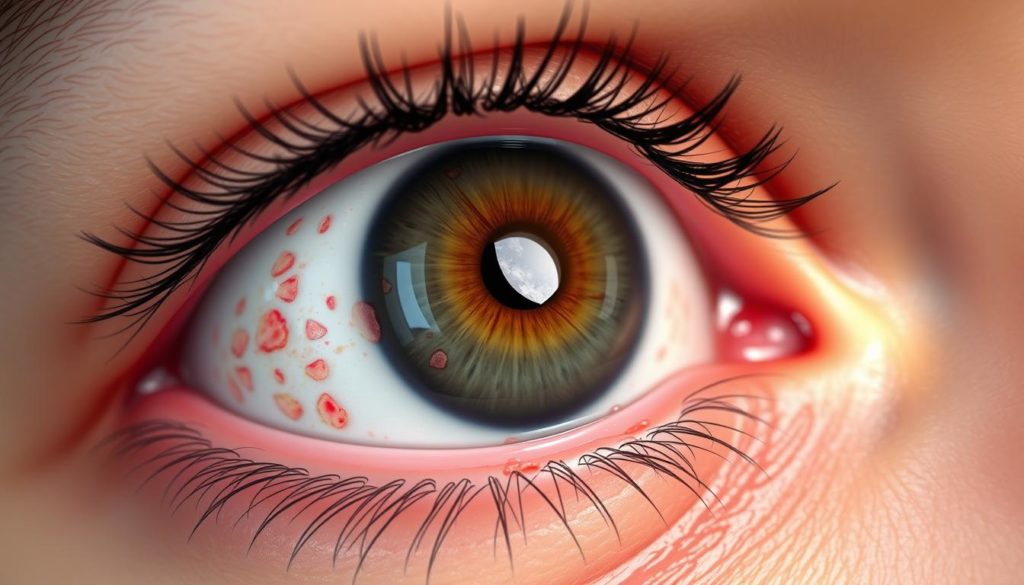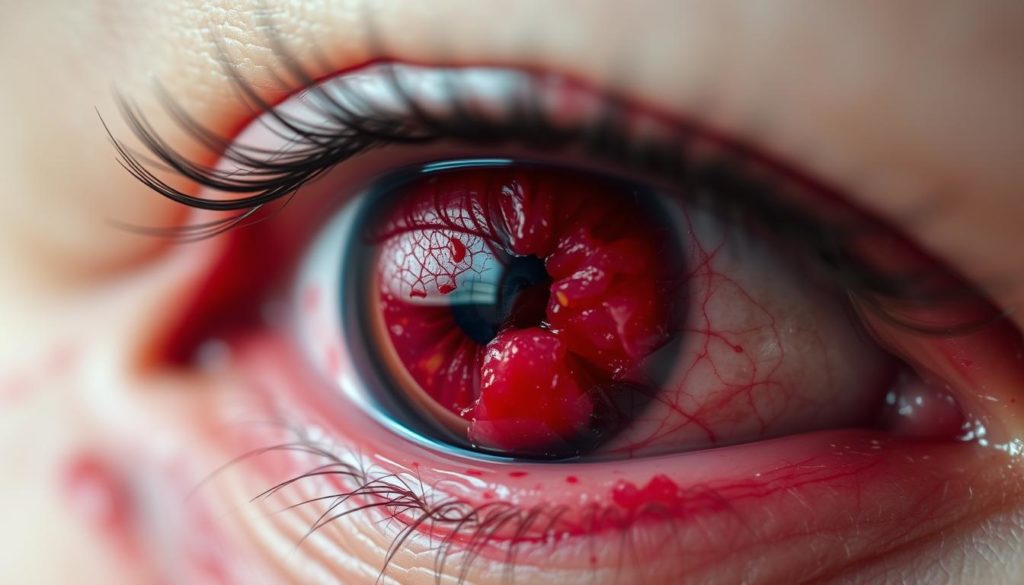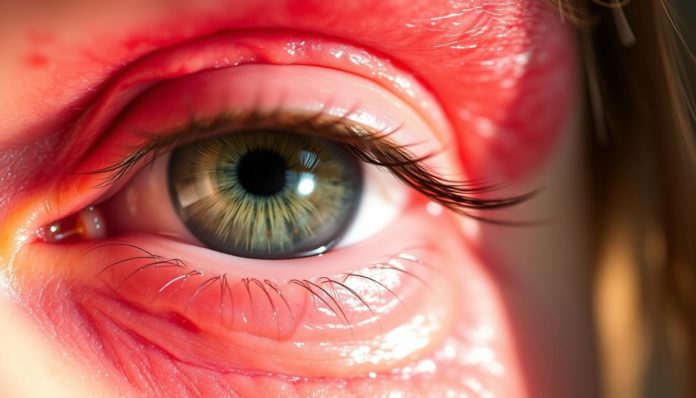Scleritis is a painful and serious eye problem. It happens when the white part of the eye gets inflamed. This issue can cause a lot of pain, red eyes, and swelling.
Knowing the early signs is very important. Catching it early means you can get treatment fast. This helps avoid big problems like losing your sight.
If your eyes hurt for no clear reason, feel tender, or you can’t see well, get help. Seeing an eye doctor right away is crucial. Quick action helps keep your eyes healthy and your vision clear. So, it’s smart to learn about scleritis. That way, you can protect your sight.
What is Scleritis?
Scleritis is a serious condition that inflames the sclera, or the white part of the eye. People with scleritis may feel strong eye pain, see redness, and feel tenderness. The pain is often a sign that you need to seek help quickly.

Overview of Scleritis
Scleritis shows up with signs like lasting eye pain and redness. These may point to bigger health issues, like autoimmune disorders. Disorders such as rheumatoid arthritis can be connected. While the exact causes of scleritis differ, common ones include infections and injuries. Spotting these signs early is vital for successful treatment.
Importance of Early Diagnosis
Early detection of scleritis is key. It lets doctors tackle the main causes quickly, which can save your sight. Seeing an eye doctor at the first sign of trouble means treatments can start right away. This approach reduces risks and helps patients get better sooner.
Common Signs of Scleritis
Scleritis is a serious eye condition needing quick action because of its harmful effects. Knowing the main symptoms of scleritis helps catch it early and treat it.
Eye Pain and Tenderness
Severe eye pain and tenderness are key signs of scleritis. This pain can get worse with eye movements or at night. It is often described as a deep, aching feeling.
Redness and Swelling
The white part of the eye becomes inflamed, causing redness and swelling. This marks common signs of scleritis. The swelling can increase discomfort and might be seen from the outside.

Blurred Vision and Sensitivity to Light
Patients with scleritis might have blurred vision and find lights too bright. These symptoms can disrupt daily life. Blurry vision happens when the inflamed sclera affects sight. Increased light sensitivity comes from the inflamed tissues reacting more to light.
Scleritis Symptoms and Causes
Scleritis is a serious condition that inflames the sclera of the eye. Knowing the causes and symptoms is key to handle it well.
Link to Autoimmune Disorders
Many scleritis cases are tied to autoimmune diseases. Conditions like rheumatoid arthritis, lupus, and Sjogren’s syndrome can spark inflammation, leading to scleritis. These diseases make the immune system attack the body by mistake. This causes the painful symptoms of scleritis.
Other Contributing Factors
Other causes of scleritis include eye injuries, infections, and rarely, fungal or parasitic infections. These can cause symptoms from slight eye redness to intense pain and trouble seeing. It’s vital to address these causes early to avoid lasting harm and keep eyes healthy.
Types of Scleritis
Scleritis is a severe eye condition with various forms. It mainly appears as anterior scleritis and posterior scleritis. It’s important to know these types to correctly identify and treat the condition.
Anterior Scleritis
Anterior scleritis is more common and affects the eye’s front part. Symptoms like redness and eye irritation are common. It has different levels of severity, and each responds differently to treatments.
- Persistent eye redness
- Localized irritation
- Possible vision impairment
Posterior Scleritis
Posterior scleritis is less common and impacts the eye’s back part. If overlooked, it can cause serious issues like retinal detachment and angle-closure glaucoma. Symptoms might be less noticeable but can include:
- Deep-seated eye pain
- Reduced vision
- Possible bulging of the eye
| Characteristic | Anterior Scleritis | Posterior Scleritis |
|---|---|---|
| Commonality | Most Common | Rare |
| Location of Inflammation | Front of the Eye | Back of the Eye |
| Primary Symptoms | Redness, Irritation | Deep Pain, Vision Loss |
| Potential Complications | Varies from Treatable to Severe | Retinal Detachment, Angle-Closure Glaucoma |
Knowing the symptoms of both anterior scleritis and posterior scleritis is key. Early detection and proper treatment are crucial.
Distinguishing Between Anterior and Posterior Scleritis
It’s very important to tell the difference between anterior and posterior scleritis for good care. The symptoms of each kind can greatly affect how the condition progresses. It also influences which scleritis treatment options are chosen.
Symptoms and Complications of Each Type
Both types of scleritis have their own symptoms and possible problems. This means they need different ways to diagnose and treat them.
- Anterior Scleritis: Shows up as visible bumps, intense pain, and redness. Patients might feel soreness and have watery eyes.
- Posterior Scleritis: This type can cause more serious issues like retinal detachment, bulging eyes, or loss of vision. Signs include deep eye pain and possible puffiness behind the eye.
Comparative Analysis
To accurately tell these two types apart, using advanced tools like a slit lamp microscope is key. This method ensures a precise scleritis diagnosis. It helps in choosing the right scleritis treatment options.
| Type | Symptoms | Complications |
|---|---|---|
| Anterior Scleritis | Nodules, severe pain, redness, tenderness, tearing | Potential for chronic pain and ongoing inflammation |
| Posterior Scleritis | Deep ocular pain, possible swelling behind the eye | Retinal detachment, proptosis, vision loss |
Autoimmune Diseases Associated with Scleritis
Scleritis is when your body’s defense system attacks your eyes. It often happens with autoimmune diseases. These make the immune system fight the body itself. This leads to eye problems.
Three autoimmune diseases linked with scleritis are rheumatoid arthritis, lupus, and Sjogren’s Syndrome. Diseases of the bowel can also cause eye inflammation from scleritis.
Rheumatoid Arthritis
Rheumatoid arthritis affects more than just joints. It can lead to scleritis in some people. Because rheumatoid arthritis causes lasting inflammation, it can make the eyes swell. This shows how rheumatoid arthritis and scleritis are connected. Treating arthritis well can help calm the eye swelling.
Lupus and Sjogren’s Syndrome
Lupus and Sjogren’s Syndrome both cause your immune system to attack your body. Lupus can harm many organs, including the eyes, which might lead to scleritis. Sjogren’s Syndrome mainly attacks glands that make moisture but can also affect the eyes. It’s vital to manage these diseases to control eye inflammation.
Inflammatory Bowel Disease
Inflammatory bowel diseases like Crohn’s disease and ulcerative colitis cause gut inflammation. They can also lead to problems like scleritis. The long-term swelling in these bowel diseases can spread to the eyes. Treating the bowel condition often helps lessen the eye inflammation.
Infections and Trauma as Scleritis Causes
Scleritis is a serious inflammation of the eye’s sclera, often due to various factors. These include infections and trauma. While autoimmune diseases are usually blamed, we must not overlook infections and injuries. Recognizing these can help in creating better treatment plans.
Fungal, Parasitic Infections
Fungi and parasites can also cause Scleritis. Fungal infections often come from using dirty contact lenses or being in certain places. If parasites are the culprits, it’s likely in areas where these bugs are common. It’s important to detect these early and treat them right to avoid bigger problems.
Eye Injuries Leading to Inflammation
Injuries can also lead to Scleritis. This can happen if the eye is hurt in an accident, during surgery, or by something foreign. Even small injuries can get worse. So, it’s key to get medical help quickly. This helps lower the risks and aids in healing.
Clinical Diagnosis of Scleritis
Starting to identify and diagnose scleritis involves a detailed scleritis eye examination. Tools like the slit lamp microscope are essential. They let eye doctors closely inspect the eye’s layers. This is a vital step in scleritis clinical diagnosis to find the inflammation of the sclera.
After the slit lamp exam, other tests become key for a solid diagnosis. Techniques like ultrasound or MRI help give a full picture of the condition, especially for suspected posterior scleritis. Seeing a rheumatologist might also be needed, as scleritis often goes hand in hand with autoimmune diseases.
A complete scleritis eye examination may include blood tests for autoimmune disease markers. These tests help identify any underlying conditions contributing to scleritis. By using all these diagnostic methods together, doctors can be sure about their scleritis clinical diagnosis.
Treatment Options for Scleritis
To treat scleritis, a well-planned strategy is vital to reduce inflammation and avoid more eye harm. The treatment is adapted based on the scleritis type, how severe it is, and any underlying health issues. Here are the main treatments
Steroid Eye Drops and Pills
For those with mild to moderate scleritis, steroids are typically the start of treatment. Topical steroid eye drops are used to lessen the inflammation. In worse cases, doctors might give oral steroids. These drugs work to lower inflammation and ease symptoms like pain and the eyes turning red.
Nonsteroidal Anti-Inflammatory Drugs (NSAIDs)
NSAIDs, like ibuprofen and naproxen, can control pain and swelling for scleritis. They’re great for light cases or along with other treatments. Using NSAIDs often can greatly lessen discomfort and help the eyes stay healthy.
Immunosuppressive Drugs for Severe Cases
If scleritis is bad or comes with an autoimmune disease, stronger treatment may be needed. Medicines like methotrexate, azathioprine, or cyclosporine keep the immune system from attacking eye tissues. This immunosuppressive therapy is key to stop lasting damage and keep eyesight.
Finding the right treatment for scleritis allows patients to handle their condition effectively. Whether it’s NSAIDs or stronger therapy, following doctor’s advice closely gives the best chance at a good outcome.
Surgical Interventions for Severe Scleritis
Sometimes, scleritis gets worse even with treatment. Then, surgery becomes very important. It can cause big problems for the eye, like damage. The goal of surgery is to help the condition and save the patient’s sight.
When Surgery is Needed
Surgery becomes an option for severe scleritis if medicine doesn’t help. It’s also considered when there’s thinning of the sclera or retinal detachment. Doctors look for signs like ongoing pain, worsened vision, or eye shape changes. Without help, these problems could lead to permanent vision loss. Acting fast is key to saving sight.
Types of Surgical Procedures
There are different surgeries for treating severe scleritis. One way is to use a scleral graft. This means replacing damaged eye parts with healthy ones. Another method is vitrectomy, especially if there’s a risk of the retina detaching. This takes out the vitreous gel to reduce pressure. These surgeries help prevent more vision loss. Doctors choose the best method based on the person’s situation and eye damage.
To learn more, check the American Academy of Ophthalmology. They have a lot of information on scleritis surgery and how it helps in tough cases.
FAQ
What are the common symptoms of Scleritis?
If you have Scleritis, you might feel a lot of eye pain. Your eyes can get red and the sclera may swell. Blurry vision and sensitivity to light are also common.
How important is early diagnosis of Scleritis?
Finding out you have Scleritis early is key. It helps start treatment fast. This is crucial to avoid vision loss and tackle other related illnesses.
What is the link between Scleritis and autoimmune disorders?
Scleritis often goes hand in hand with autoimmune diseases. Conditions like rheumatoid arthritis, lupus, and Sjogren’s syndrome can inflame the eyes, leading to scleritis.
Are there different types of Scleritis?
Yes, there are two main kinds – anterior and posterior. Anterior scleritis is in the front of the sclera. Posterior scleritis is at the back and can cause big problems.
What are the typical signs of anterior and posterior Scleritis?
Signs of anterior scleritis include redness, pain, and lumps. Posterior scleritis can lead to serious eye issues like the retina coming off. Both types need a doctor’s attention.
Can infections or trauma lead to Scleritis?
Yes, infections or hurt to the eye, though rare, can bring on scleritis. Fungal and parasitic infections are common culprits.
How is Scleritis diagnosed?
Doctors check your eyes closely with a slit lamp microscope to diagnose scleritis. Sometimes, they might ask for more tests or a rheumatologist’s help for a full check-up.
What are the treatment options for Scleritis?
Treatments vary from steroid drops and painkillers to strong immunity drugs for tough cases. The treatment matches the scleritis type and other health issues.
When is surgery required for Scleritis?
Surgery is sometimes needed for hard-to-treat scleritis or when the eye is hurt. The aim is to fix eye damage and prevent more vision loss.
What are the signs of Scleritis associated with autoimmune diseases like rheumatoid arthritis and lupus?
People with autoimmune diseases often have eye signs like redness, pain, and swelling. This suggests scleritis. Treating the main illness is crucial to lessen eye inflammation.


